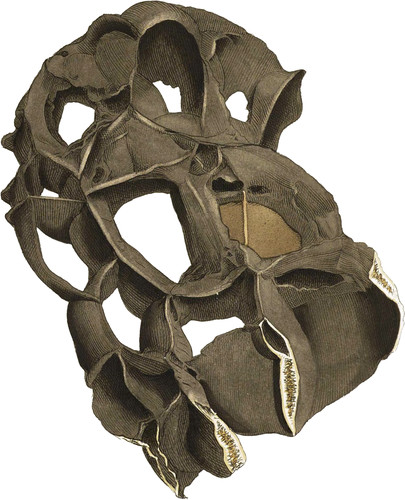 Enlarge
Enlarge
British Mineralogy
Quartz Septarium
- Div. 2. Imitative.
Quartz is metamorphosed into so many different shapes, that we never can be aware of the varieties ; and the appearance of the present specimen would by no means indicate such a substance. From its dull appearance it has generally been taken for Lead, or some other metal, as it looks as if easily flexible. The hardness and sharpness of the delicately acute edges, however, soon betray it, and the fractures, showing its crystallization, pretty readily determine it.
It seems quite natural to most Quartz to have been in solution. In this instance, having evidently formed itself in the cracks of the Clay, it is the more instructive; for whatever might have held the Quartz in solution, might, at the same time, have decomposed the Clay, which, however, must have been dry enough to have cracked, and formed sharp and neatly distinct fissures, so beautifully shown by the Quartz. But if fire had dissolved the Quartz, the Clay would have been baked: and that is not the case; as the latter, in its common state, remains in some of the fissures. This specimen is the production of Cumberland, and I have been favoured by the Rev. Mr. Harriman and Mr. Oliver with a piece about a foot in length from which the Clay had apparently been washed out, chiefly on one side. The present specimen, however, is remarkable for the incurved structure of the Septæ.
Perhaps an attention to the nature of the subject will give a theory for the cause, or lead us nearer to the cause in question. Thus the general contrarieties of heat and cold may be the cause. Clay cracks from contraction in cold or frosty giving out much of its water into the fissures, which latter, becoming impregnated with Quartz (which may be crystallized from a saturated solution in any medium), thus retains its position, and afterwards the water may wash away the Clay under various circumstances.
I do not know whether it is pure water that forms in the cracks of frosty Clay; perhaps it may be impregnated with Quartz, whose natural temperature will not allow above a certain quantity to remain with the Clay*. This might be really of consequence enough to be inquired into by those who have the opportunity.
- * Common Clay is mostly a mixture (strictly speaking) of Silex and pure Argilla, and is often so called when the Quartz contained in it amounts to sixty, or even ninety, per cent.

